High Pectin Recovery from Cocoa Husks Using an Autoclave Approach: An Analysis of Its Physicochemical, Structural, and Genotoxicity Properties
Abstract
:1. Introduction
2. Materials and Methods
2.1. Sample Preparation and Chemicals
2.2. Pectin Extraction
2.3. Experimental Design
2.4. Physicochemical and Structural Characteristics of Pectin
2.4.1. Color, pH, Moisture Content, and Water Activity (aw)
2.4.2. Equivalent Weight and Methoxyl Content (MeO,%)
2.4.3. Degree of Esterification (DE,%) and Anhydrouronic Acid Content (AUA,%)
2.4.4. Intrinsic Viscosity and Viscosity–Average Molecular Weight (Mv)
2.4.5. Water- and Oil-Holding Capacity (WHC and OHC)
2.4.6. Water Solubility Index (WSI)
2.4.7. Rheological Measurements
2.5. Genotoxicity Analysis of CHP
2.6. Statistical Analysis
3. Results and Discussions
3.1. Accuracy and Variance of the Regression Model
3.2. Effect of Independent Variables on Cocoa Husk Pectin (CHP) Yield
3.3. Optimization and Validation of Extraction Conditions
3.4. Physicochemical and Structural Characteristics of Pectin
3.4.1. Product Color, pH, Moisture Content, and Water Activity
3.4.2. Equivalent Weight, Methoxyl Content (MeO), Anhydrouronic Acid (AUA) Content, Degree of Esterification (DE), Intrinsic Viscosity, and Viscosity–Average Molecular Weight (Mv)
3.4.3. Water- and Oil-Holding Capacity (WHC and OHC)
3.4.4. Water Solubility Index (WSI)
3.4.5. Rheological Measurements
3.5. Pesticides and Heavy Metal Analysis of Raw Materials and CHP
3.6. Genotoxicity Determination Using the Bacterial Reverse Mutation Test (Ames Test)
4. Conclusions
Supplementary Materials
Author Contributions
Funding
Institutional Review Board Statement
Informed Consent Statement
Data Availability Statement
Acknowledgments
Conflicts of Interest
References
- Handojo, L.; Triharyogi, H.; Indarto, A. Cocoa bean shell waste as potential raw material for dietary fiber powder. Int. J. Recycl. Org. Waste Agric. 2019, 8, 485–491. [Google Scholar] [CrossRef]
- Forero-Nuñez, C.; Jochum, J.; Sierra, F. Effect of particle size and addition of cocoa pod husk on the properties of sawdust and coal pellets. Ing. E Investig. 2015, 35, 17–23. [Google Scholar] [CrossRef]
- Mansur, D.; Tago, T.; Masuda, T.; Abimanyu, H. Conversion of cacao pod husks by pyrolysis and catalytic reaction to produce useful chemicals. Biomass Bioenergy 2014, 66, 275–285. [Google Scholar] [CrossRef]
- Dogbatse, J.A.; Arthur, A.; Padi, F.K.; Konlan, S.; Quaye, A.K.; Owusu-Ansah, F.; Awudzi, G.K. Influence of Acidic Soils on Growth and Nutrient Uptake of Cocoa (Theobroma cacao L.) Varieties. Commun. Soil Sci. Plant Anal. 2020, 51, 2280–2296. [Google Scholar] [CrossRef]
- Vanitha, T.; Khan, M. Role of Pectin in Food Processing and Food Packaging; IntechOpen Limited: London, UK, 2019. [Google Scholar]
- Chandel, V.; Biswas, D.; Roy, S.; Vaidya, D.; Verma, A.; Gupta, A. Current Advancements in Pectin: Extraction, Properties and Multifunctional Applications. Foods 2022, 11, 2683. [Google Scholar] [CrossRef]
- Seisun, D.; Zalesny, N. Strides in food texture and hydrocolloids. Food Hydrocoll. 2021, 117, 106575. [Google Scholar] [CrossRef]
- May, C.D. Industrial pectins: Sources, production and applications. Carbohydr. Polym. 1990, 12, 79–99. [Google Scholar] [CrossRef]
- Wang, M.; Huang, B.; Fan, C.; Zhao, K.; Hu, H.; Xu, X.; Pan, S.; Liu, F. Characterization and functional properties of mango peel pectin extracted by ultrasound assisted citric acid. Int. J. Biol. Macromol. 2016, 91, 794–803. [Google Scholar] [CrossRef]
- Jong, S.H.; Abdullah, N.; Muhammad, N. Optimization of low-methoxyl pectin extraction from durian rinds and its physicochemical characterization. Carbohydr. Polym. Technol. Appl. 2023, 5, 100263. [Google Scholar] [CrossRef]
- Priyangini, F.S.; Walde, G.; Chidambaram, R. Extraction optimization of pectin from cocoa pod husks (Theobroma cacao L.) with ascorbic acid using response surface methodology. Carbohydr. Polym. 2018, 202, 497–503. [Google Scholar] [CrossRef] [PubMed]
- Yapo, B.M.; Robert, C.; Etienne, I.; Wathelet, B.; Paquot, M. Effect of extraction conditions on the yield, purity and surface properties of sugar beet pulp pectin extracts. Food Chem. 2007, 100, 1356–1364. [Google Scholar] [CrossRef]
- Barrios-Rodríguez, Y.F.; Salas-Calderón, K.T.; Orozco-Blanco, D.A.; Gentile, P.; Girón-Hernández, J. Cocoa Pod Husk: A High-Pectin Source with Applications in the Food and Biomedical Fields. ChemBioEng Rev. 2022, 9, 462–474. [Google Scholar] [CrossRef]
- Vriesmann, L.C.; de Mello Castanho Amboni, R.D.; de Oliveira Petkowicz, C.L. Cacao pod husks (Theobroma cacao L.): Composition and hot-water-soluble pectins. Ind. Crops Prod. 2011, 34, 1173–1181. [Google Scholar] [CrossRef]
- Wulandari, R.; Suyatma, N.E.; Budi, F.S.; Utami, R.R. Optimization of Pectin Extraction from Cacao Pods Using Microwave Assisted Extraction (MAE) as a Sustainable Method for on-Farm Waste Utilization. In IOP Conference Series: Earth and Environmental Science; IOP Publishing: Bristol, UK, 2023; Volume 1241, p. 012082. [Google Scholar]
- Sarah, M.; Hasibuan, I.M.; Misran, E.; Maulina, S. Optimization of Microwave-Assisted Pectin Extraction from Cocoa Pod Husk. Molecules 2022, 27, 6544. [Google Scholar] [CrossRef]
- AOAC. Official Method of Analysis of AOAC Internation, 21 ed.; Arlington, V.A., Ed.; AOAC International: Rockville, MD, USA, 2019. [Google Scholar]
- Phaiphan, A.; Churat, S.; Doungta, T.; Wichalin, P.; Khanchai, W.; Penjumras, P. Effects of microwave and ultrasound on the extraction of pectin and its chemical characterisation of banana (Musa sapientum L.) peels. Food Res. 2020, 4, 2030–2036. [Google Scholar] [CrossRef] [PubMed]
- Fakayode, O.A.; Abobi, K.E. Optimization of oil and pectin extraction from orange (Citrus sinensis) peels: A response surface approach. J. Anal. Sci. Technol. 2018, 9, 20. [Google Scholar] [CrossRef]
- Chaliha, M.; Williams, D.; Smyth, H.; Sultanbawa, Y. Extraction and characterization of a novel Terminalia pectin. Food Sci. Biotechnol. 2018, 27, 65–71. [Google Scholar] [CrossRef] [PubMed]
- Shivamathi, C.S.; Gunaseelan, S.; Soosai, M.R.; Vignesh, N.S.; Varalakshmi, P.; Kumar, R.S.; Karthikumar, S.; Kumar, R.V.; Baskar, R.; Rigby, S.P.; et al. Process optimization and characterization of pectin derived from underexploited pineapple peel biowaste as a value-added product. Food Hydrocoll. 2022, 123, 107141. [Google Scholar] [CrossRef]
- Liu, L.; Cao, J.; Huang, J.; Cai, Y.; Yao, J. Extraction of pectins with different degrees of esterification from mulberry branch bark. Bioresour. Technol. 2010, 101, 3268–3273. [Google Scholar] [CrossRef] [PubMed]
- Maneerat, N.; Tangsuphoom, N.; Nitithamyong, A. Effect of extraction condition on properties of pectin from banana peels and its function as fat replacer in salad cream. J. Food Sci. Technol. 2017, 54, 386–397. [Google Scholar] [CrossRef] [PubMed]
- Migliori, M.; Gabriele, D.; Checchetti, A.; Battipede, B. Compatibility analysis of pectin at different esterification degree from intrinsic viscosity data of diluted ternary solutions. React. Funct. Polym. 2010, 70, 863–867. [Google Scholar] [CrossRef]
- Kazemi, M.; Khodaiyan, F.; Hosseini, S.S. Utilization of food processing wastes of eggplant as a high potential pectin source and characterization of extracted pectin. Food Chem. 2019, 294, 339–346. [Google Scholar] [CrossRef]
- Begum, R.; Yusof, Y.A.; Aziz, M.G.; Uddin, M.B. Structural and functional properties of pectin extracted from jackfruit (Artocarpus heterophyllus) waste: Effects of drying. Int. J. Food Prop. 2017, 20, S190–S201. [Google Scholar] [CrossRef]
- OECD. Test No. 471: Bacterial Reverse Mutation Test; OECD Publishing: Paris, France, 2020. [Google Scholar]
- Inthachat, W.; Temviriyanukul, P.; On-Nom, N.; Kanoongon, P.; Thangsiri, S.; Chupeerach, C.; Suttisansanee, U. Optimization of Phytochemical-Rich Citrus maxima Albedo Extract Using Response Surface Methodology. Molecules 2023, 28, 4121. [Google Scholar] [CrossRef] [PubMed]
- Inthachat, W.; Thangsiri, S.; Khemthong, C.; On-Nom, N.; Chupeerach, C.; Sahasakul, Y.; Temviriyanukul, P.; Suttisansanee, U. Green Extraction of Hodgsonia heteroclita Oilseed Cake Powder to Obtain Optimal Antioxidants and Health Benefits. Foods 2023, 12, 4281. [Google Scholar] [CrossRef]
- On-Nom, N.; Promdang, P.; Inthachat, W.; Kanoongon, P.; Sahasakul, Y.; Chupeerach, C.; Suttisansanee, U.; Temviriyanukul, P. Wolffia globosa-Based Nutritious Snack Formulation with High Protein and Dietary Fiber Contents. Foods 2023, 12, 2647. [Google Scholar] [CrossRef] [PubMed]
- Hosseini, S.S.; Khodaiyan, F.; Yarmand, M.S. Optimization of microwave assisted extraction of pectin from sour orange peel and its physicochemical properties. Carbohydr. Polym. 2016, 140, 59–65. [Google Scholar] [CrossRef]
- Khodaiyan, F.; Razavi, S.H.; Mousavi, S.M. Optimization of canthaxanthin production by Dietzia natronolimnaea HS-1 from cheese whey using statistical experimental methods. Biochem. Eng. J. 2008, 40, 415–422. [Google Scholar] [CrossRef]
- Maran, J.P.; Sivakumar, V.; Thirugnanasambandham, K.; Sridhar, R. Microwave assisted extraction of pectin from waste Citrullus lanatus fruit rinds. Carbohydr. Polym. 2014, 101, 786–791. [Google Scholar] [CrossRef]
- Masmoudi, M.; Besbes, S.; Chaabouni, M.; Robert, C.; Paquot, M.; Blecker, C.; Attia, H. Optimization of pectin extraction from lemon by-product with acidified date juice using response surface methodology. Carbohydr. Polym. 2008, 74, 185–192. [Google Scholar] [CrossRef]
- Karim, R.; Uddin, M.; Jubayer, M. Optimization of pectin isolation method from pineapple (Ananas comosus l.) waste. Carpathian J. Food Sci. Technol. 2014, 6, 116–122. [Google Scholar]
- Li, W.; Zhang, F.; Liu, P.; Bai, Y.; Gao, L.; Shen, Q. Effect of high hydrostatic pressure on physicochemical, thermal and morphological properties of mung bean (Vigna radiata L.) starch. J. Food Eng. 2011, 103, 388–393. [Google Scholar] [CrossRef]
- Ma, X.; Jing, J.; Wang, J.; Xu, J.; Hu, Z. Extraction of Low Methoxyl Pectin from Fresh Sunflower Heads by Subcritical Water Extraction. ACS Omega 2020, 5, 15095–15104. [Google Scholar] [CrossRef] [PubMed]
- Oloye, M.T.; Jabar, J.M.; Adetuyi, A.O.; Lajide, L. Extraction and characterization of pectin from fruit peels of Irvingia gabonensis and pulp of Cola milleni and Theobroma cacao as precursor for industrial applications. Biomass Convers. Biorefinery 2023, 13, 2125–2133. [Google Scholar] [CrossRef]
- Mellinas, A.C.; Jiménez, A.; Garrigós, M.C. Optimization of microwave-assisted extraction of cocoa bean shell waste and evaluation of its antioxidant, physicochemical and functional properties. LWT 2020, 127, 109361. [Google Scholar] [CrossRef]
- Hennessey-Ramos, L.; Murillo-Arango, W.; Vasco-Correa, J.; Astudillo, I.C.P. Enzymatic Extraction and Characterization of Pectin from Cocoa Pod Husks (Theobroma cacao L.) Using Celluclast® 1.5 L. Molecules 2021, 26, 1473. [Google Scholar] [CrossRef] [PubMed]
- Kayaputri, I.L.; Djali, M.; Sukri, N.; Fazaryasti, R.H. The Antimicrobial Effectiveness of Cacao Shell and Cacao Husk Combination on Inhibition of Pathogenic Bacteria in Food Products. In IOP Conference Series: Earth and Environmental Science; IOP Publishing: Bristol, UK, 2020; Volume 443, p. 012077. [Google Scholar]
- Sikder, M.B.H.; Ahmed, S. Extraction, Characterization and Application of Three Varieties of Citrus limon L. Pectin in Jelly Product. Food Appl. Biosci. J. 2018, 7, 31–50. [Google Scholar]
- FCC. Food Chemical Codex, 3rd ed.; National Academy of Science: Washington, DC, USA, 1981. [Google Scholar]
- Mamiru, D.; Gonfa, G. Extraction and characterization of pectin from watermelon rind using acetic acid. Heliyon 2023, 9, e13525. [Google Scholar] [CrossRef] [PubMed]
- Kastner, H.; Einhorn-Stoll, U.; Drusch, S. Structure formation in sugar containing pectin gels-Influence of gel composition and cooling rate on the gelation of non-amidated and amidated low-methoxylated pectin. Food Hydrocoll. 2017, 73, 13–20. [Google Scholar] [CrossRef]
- IPPA. Pectin Commercial Production and Pectin in Organic Food Products. 2022. Available online: https://pectinproducers.com/ippa-resources/pectin-in-organic-food-products-statement/ (accessed on 20 January 2024).
- Sarah, M.; Hanum, F.; Rizky, M.; Hisham, M.F. Microwave-Assisted Extraction of Pectin from Cocoa Peel. In IOP Conference Series: Earth and Environmental Science; IOP Publishing: Bristol, UK, 2018; Volume 122, p. 012079. [Google Scholar]
- Musita, N. Characteristics of Pectin Extracted from Cocoa Pod Husks. Pelita Perkeb. A Coffee Cocoa Res. J. 2021, 37, 62–75. [Google Scholar] [CrossRef]
- Cho, Y.-J.; Hwang, J.-K. Modeling the yield and intrinsic viscosity of pectin in acidic solubilization of apple pomace. J. Food Eng. 2000, 44, 85–89. [Google Scholar] [CrossRef]
- Lefsih, K.; Giacomazza, D.; Dahmoune, F.; Mangione, M.R.; Bulone, D.; Biagio, P.L.S.; Passantino, R.; Costa, M.A.; Guarrasi, V.; Madani, K. Pectin from Opuntia ficus indica: Optimization of microwave-assisted extraction and preliminary characterization. Food Chem. 2017, 221, 91–99. [Google Scholar] [CrossRef]
- Yuan, Y.; Xu, X.; Jing, C.; Zou, P.; Zhang, C.; Li, Y. Microwave assisted hydrothermal extraction of polysaccharides from Ulva prolifera: Functional properties and bioactivities. Carbohydr. Polym. 2018, 181, 902–910. [Google Scholar] [CrossRef] [PubMed]
- Elleuch, M.; Bedigian, D.; Roiseux, O.; Besbes, S.; Blecker, C.; Attia, H. Dietary fibre and fibre-rich by-products of food processing: Characterisation, technological functionality and commercial applications: A review. Food Chem. 2011, 124, 411–421. [Google Scholar] [CrossRef]
- Hua, X.; Wang, K.; Yang, R.; Kang, J.; Zhang, J. Rheological properties of natural low-methoxyl pectin extracted from sunflower head. Food Hydrocoll. 2015, 44, 122–128. [Google Scholar] [CrossRef]
- Kyomugasho, C.; Christiaens, S.; Shpigelman, A.; Loey, A.M.V.; Hendrickx, M.E. FT-IR spectroscopy, a reliable method for routine analysis of the degree of methylesterification of pectin in different fruit- and vegetable-based matrices. Food Chem. 2015, 176, 82–90. [Google Scholar] [CrossRef]
- Adejori, A.A.; Akinnagbe, O.M. Assessment of farmers′ utilization of approved pesticides in cocoa farms in Ondo state, Nigeria. Heliyon 2022, 8, e10678. [Google Scholar] [CrossRef] [PubMed]
- Afrane, G.; Ntiamoah, A. Use of Pesticides in the Cocoa Industry and Their Impact on the Environment and the Food Chain; IntechOpen Limited: London, UK, 2011. [Google Scholar]
- Idowu, G.A.; Aiyesanmi, A.F.; Oyegoke, F.O. Organochlorine pesticide residues in pods and beans of cocoa (Theobroma cacao L.) from Ondo State Central District, Nigeria. Environ. Adv. 2022, 7, 100162. [Google Scholar] [CrossRef]
- Ihedioha, J.; Ejalonibu, M.; Ekere, N. Multi-residue Analysis of Organochlorine Pesticides in Cocoa Beans (Theobroma cacao) and Soils from Ondo, Nigeria. Pak. J. Anal. Environ. Chem. 2020, 21, 219–231. [Google Scholar]
- Okoffo, E.D.; Fosu-Mensah, B.Y.; Gordon, C. Persistent organochlorine pesticide residues in cocoa beans from Ghana, a concern for public health. Int. J. Food Contam. 2016, 3, 5. [Google Scholar] [CrossRef]
- Villanueva, E.; Glorio-Paulet, P.; Giusti, M.M.; Sigurdson, G.T.; Yao, S.; Rodríguez-Saona, L.E. Screening for pesticide residues in cocoa (Theobroma cacao L.) by portable infrared spectroscopy. Talanta 2023, 257, 124386. [Google Scholar] [CrossRef]
- Mwanja, M.; Jacobs, C.; Mbewe, A.R.; Munyinda, N.S. Assessment of pesticide residue levels among locally produced fruits and vegetables in Monze district, Zambia. Int. J. Food Contam. 2017, 4, 11. [Google Scholar] [CrossRef]
- Arévalo-Gardini, E.; Arévalo-Hernández, C.O.; Baligar, V.C.; He, Z.L. Heavy metal accumulation in leaves and beans of cacao (Theobroma cacao L.) in major cacao growing regions in Peru. Sci. Total Environ. 2017, 605–606, 792–800. [Google Scholar] [CrossRef] [PubMed]
- Law, E.U. COMMISSION REGULATION (EU) No 231/2012. 2012. Available online: https://eur-lex.europa.eu/legal-content/EN/TXT/?uri=celex%3A32012R0231 (accessed on 24 January 2024).
- Kleijn, A.F.; Mutter, M.; Akingbasote, J.A.; Meetro, J.; Simon, R.R.; Muntendam, P.; Frommhagen, M.; Schols, H.A. Toxicological evaluation of a pumpkin-derived pectin preparation: In vitro genotoxicity studies and a 13-week oral toxicity study in Sprague-Dawley rats. Toxicol. Res. 2024, 13, tfae004. [Google Scholar] [CrossRef] [PubMed]
- Jonker, D.; Fowler, P.; Albers, R.; Tzoumaki, M.V.; van het Hof, K.H.; Aparicio-Vergara, M. Safety assessment of rhamnogalacturonan-enriched carrot pectin fraction: 90-Day oral toxicity study in rats and in vitro genotoxicity studies. Food Chem. Toxicol. 2020, 139, 111243. [Google Scholar] [CrossRef]
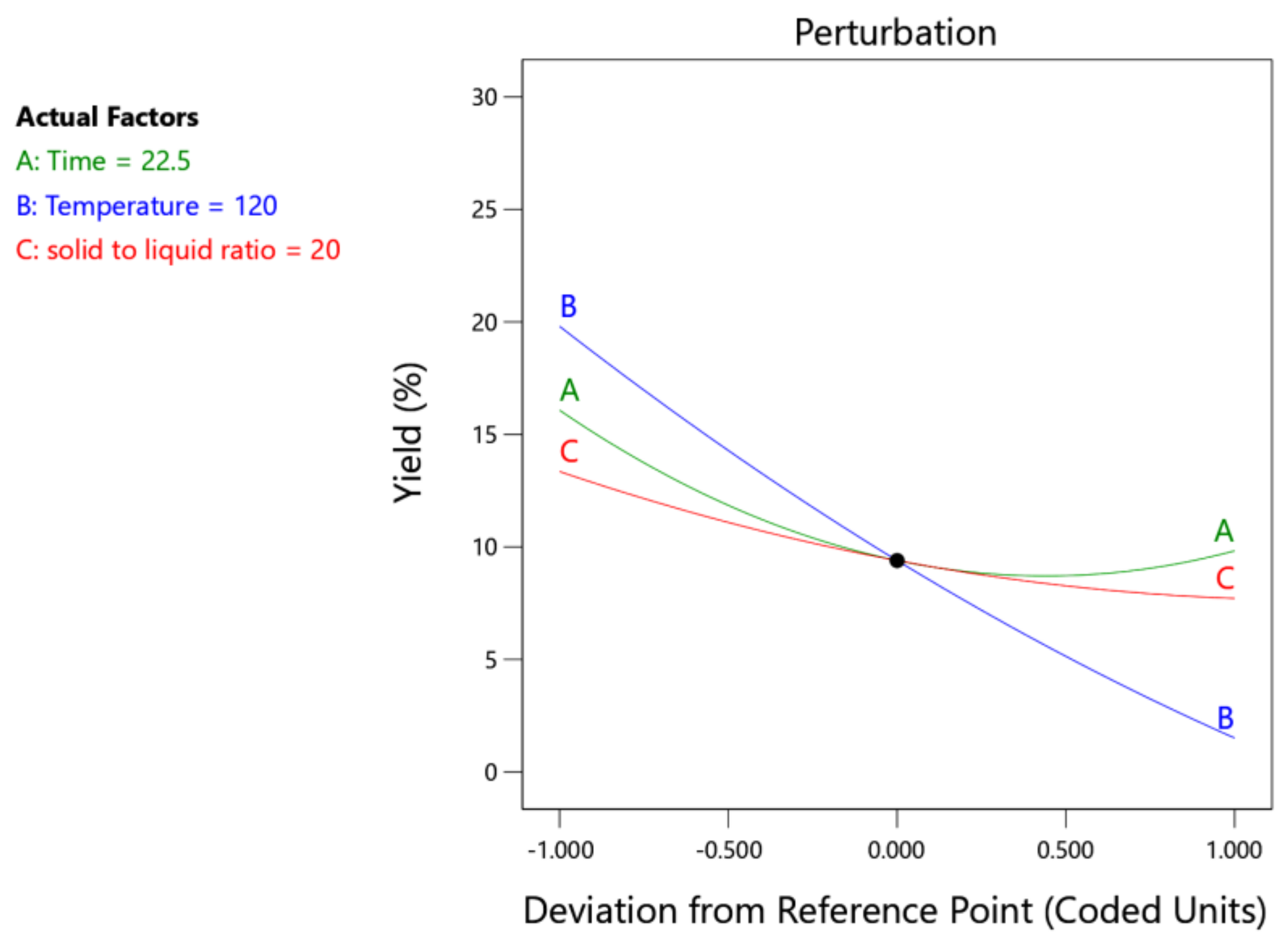
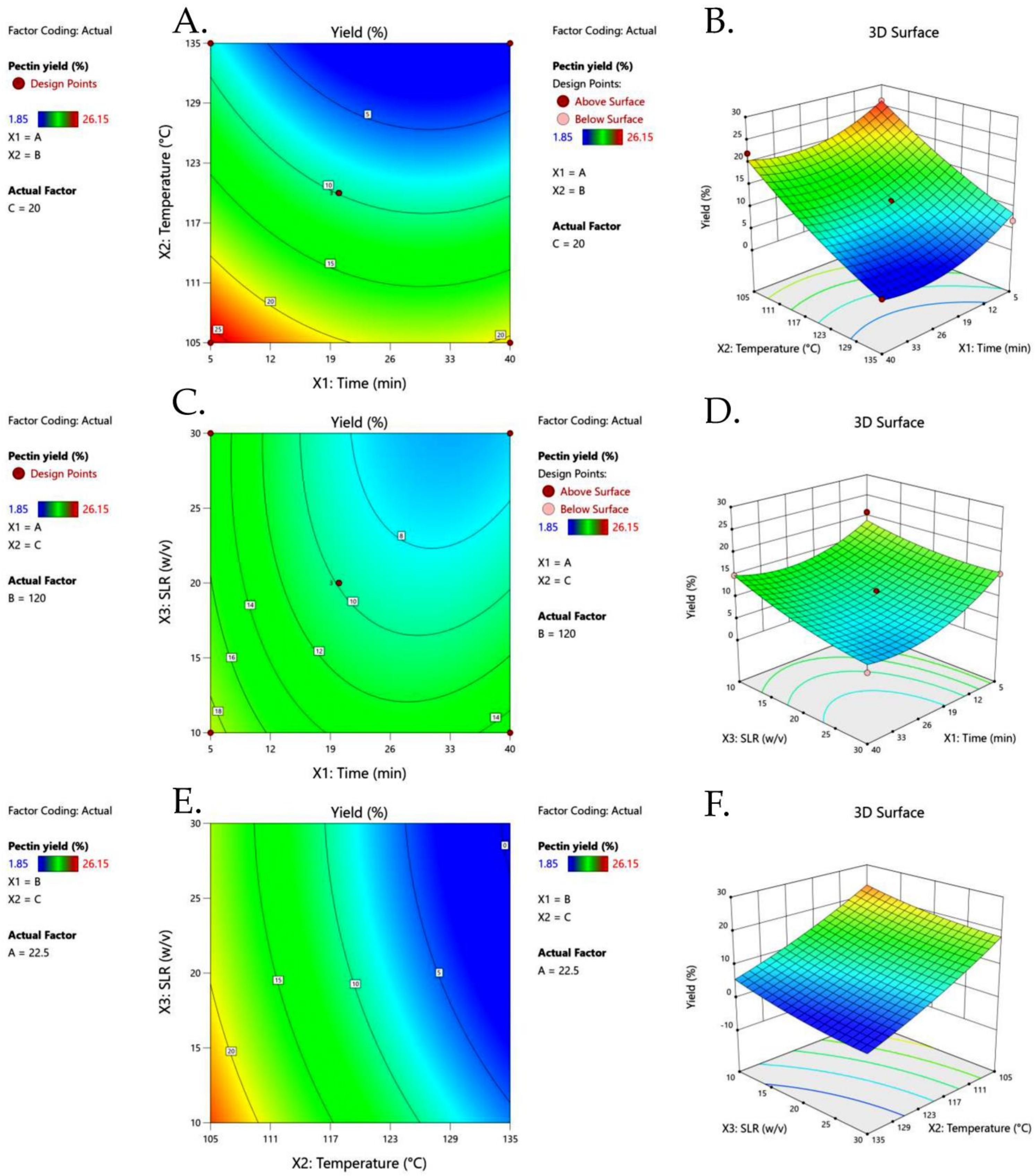
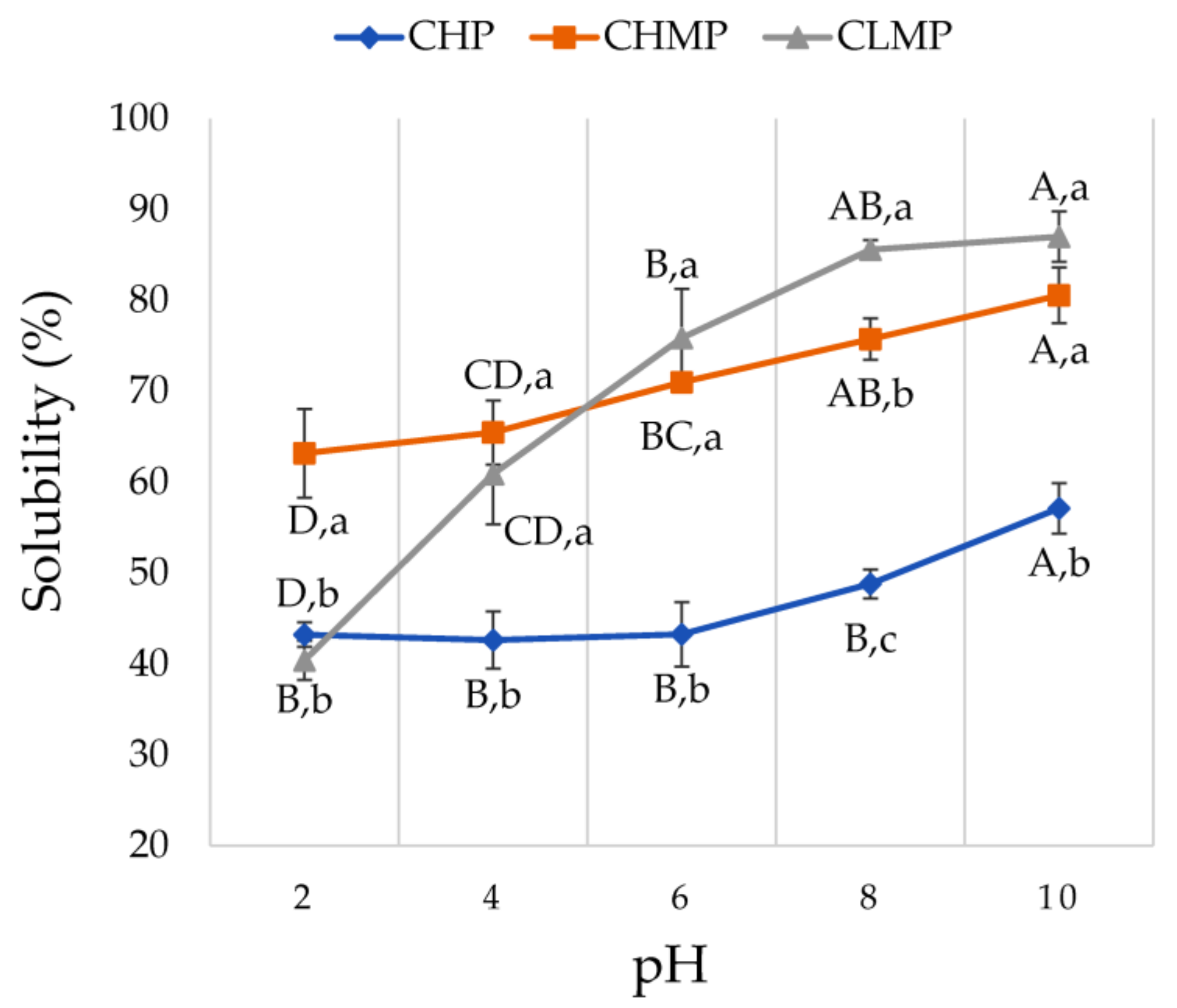
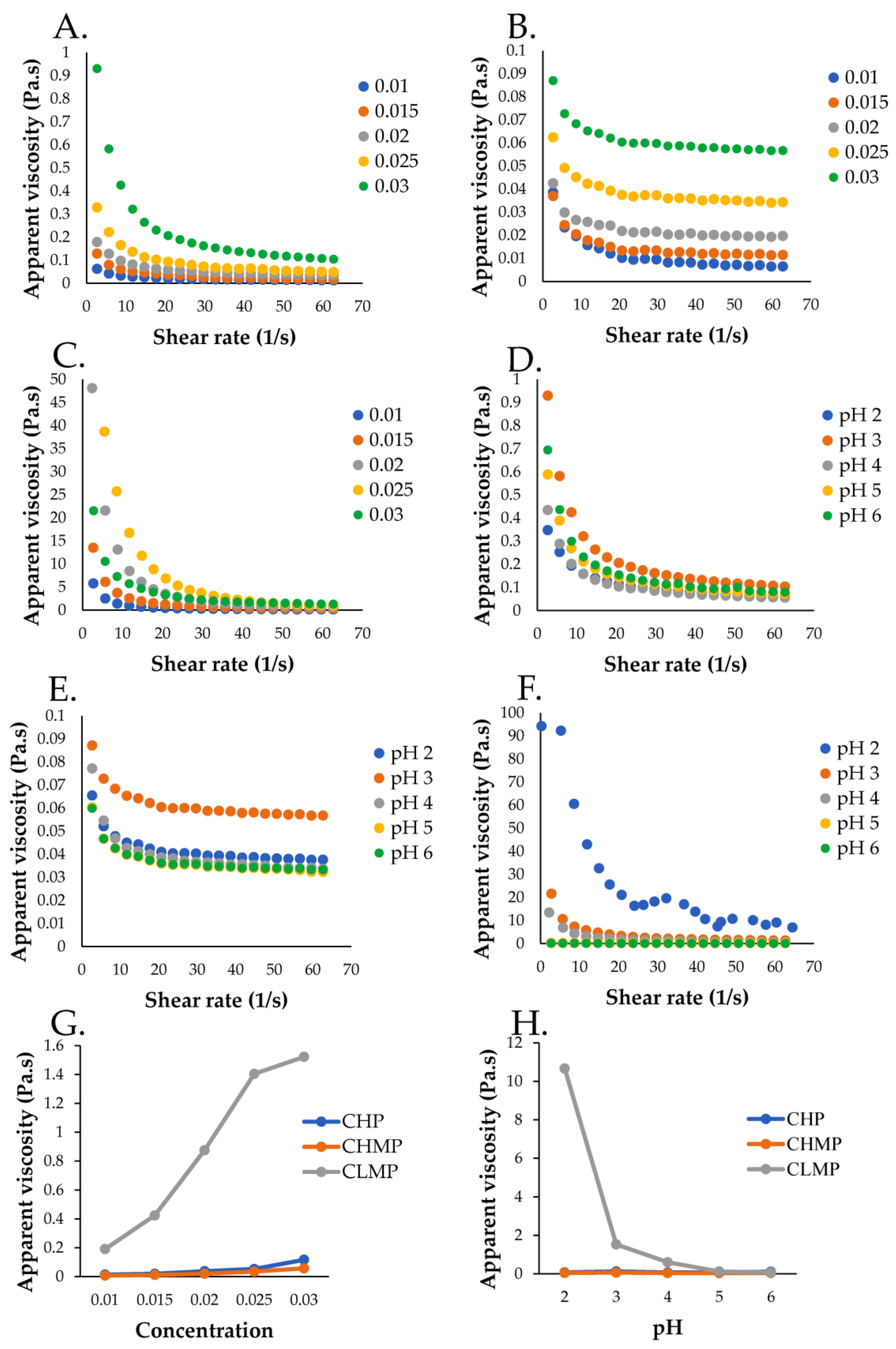
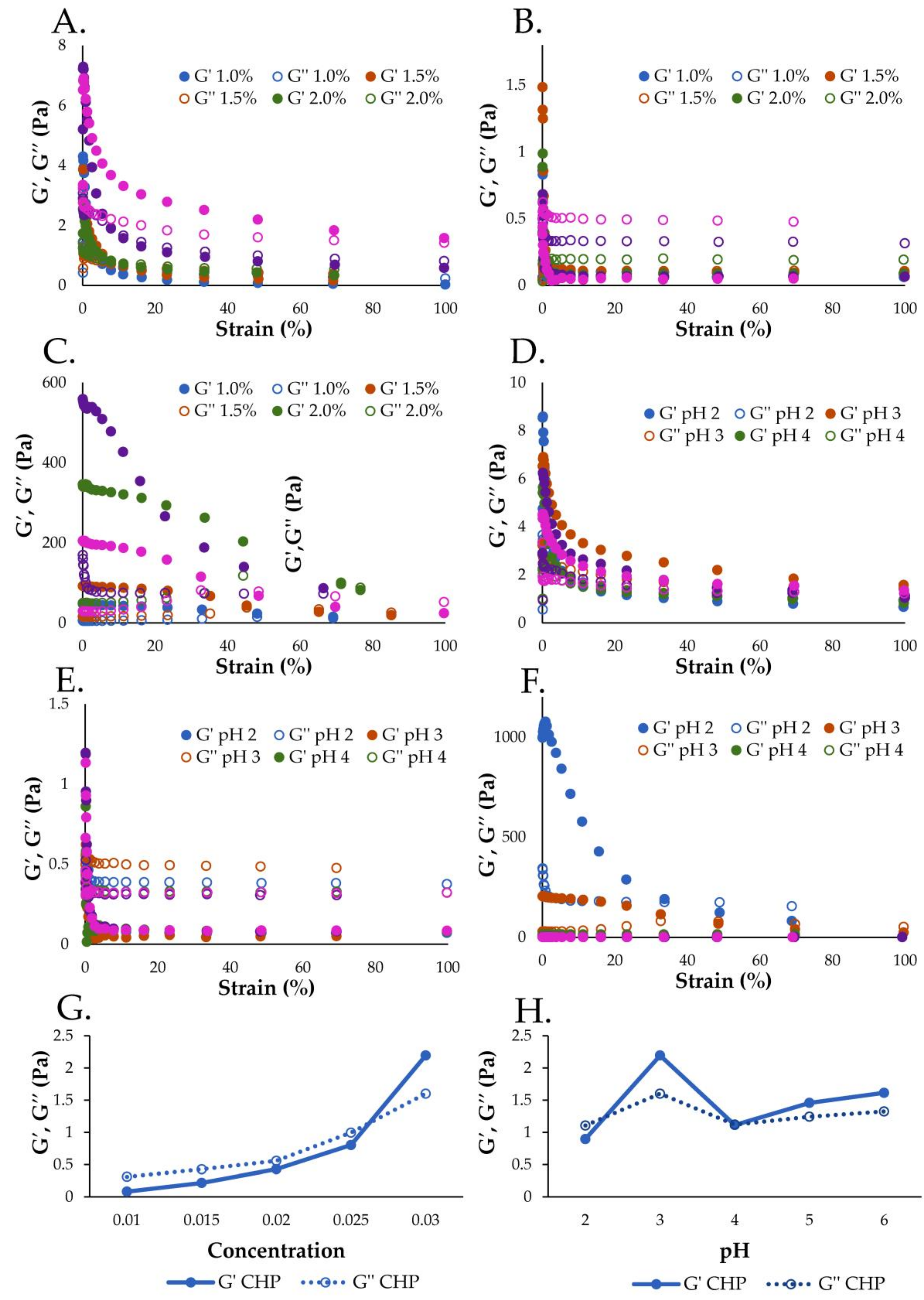
| Factors | Unit | Actual Levels | ||
|---|---|---|---|---|
| −1 | 0 | 1 | ||
| (X1) Extraction time | min | 5 | 20 | 40 |
| (X2) Extraction temperature | °C | 105 | 120 | 135 |
| (X3) Solid–liquid ratio (SLR) | w/v | 10 | 20 | 30 |
| Run | X1: Extraction Time (min) | X2: Temperature (°C) | X3: Solid–Liquid Ratio (SLR) (w/v) |
|---|---|---|---|
| 1 | 40 | 120 | 10 |
| 2 | 20 | 105 | 10 |
| 3 | 5 | 120 | 10 |
| 4 | 40 | 105 | 20 |
| 5 | 20 | 120 | 20 |
| 6 | 20 | 105 | 30 |
| 7 | 20 | 120 | 20 |
| 8 | 5 | 120 | 30 |
| 9 | 20 | 135 | 10 |
| 10 | 5 | 135 | 20 |
| 11 | 40 | 135 | 20 |
| 12 | 20 | 135 | 30 |
| 13 | 40 | 120 | 30 |
| 14 | 20 | 120 | 20 |
| 15 | 5 | 105 | 20 |
| Run | X1: Time (min) | X2: Temperature (°C) | X3: SLR (w/v) | Experimental Yield (%) | Predicted Yield (%) |
|---|---|---|---|---|---|
| 1 | 40 | 120 | 10 | 14.9 | 14.91 |
| 2 | 20 | 105 | 10 | 22.1 | 23.84 |
| 3 | 5 | 120 | 10 | 20.9 | 18.90 |
| 4 | 40 | 105 | 20 | 22.05 | 20.56 |
| 5 | 20 | 120 | 20 | 9.55 | 9.92 |
| 6 | 20 | 105 | 30 | 19.25 | 19.00 |
| 7 | 20 | 120 | 20 | 10.6 | 9.92 |
| 8 | 5 | 120 | 30 | 15.25 | 15.53 |
| 9 | 20 | 135 | 10 | 5.85 | 6.11 |
| 10 | 5 | 135 | 20 | 6.8 | 8.51 |
| 11 | 40 | 135 | 20 | 1.85 | 1.63 |
| 12 | 20 | 135 | 30 | 2.05 | 0.32 |
| 13 | 40 | 120 | 30 | 5.3 | 7.02 |
| 14 | 20 | 120 | 20 | 9.6 | 9.92 |
| 15 | 5 | 105 | 20 | 26.15 | 26.17 |
| Source | Sum of Squares | DF | Mean Square | F-Value | p-Value | Significance |
|---|---|---|---|---|---|---|
| Model | 850.49 | 9 | 94.50 | 24.78 | 0.0013 | ** |
| X1 | 78.13 | 1 | 78.13 | 20.49 | 0.0062 | ** |
| X2 | 662.75 | 1 | 662.75 | 173.81 | <0.0001 | *** |
| X3 | 62.90 | 1 | 62.90 | 16.50 | 0.0097 | ** |
| X1X2 | 0.4091 | 1 | 0.4091 | 0.1073 | 0.7565 | |
| X1X3 | 5.16 | 1 | 5.16 | 1.35 | 0.2974 | |
| X2X3 | 0.2256 | 1 | 0.2256 | 0.0592 | 0.8175 | |
| X12 | 44.35 | 1 | 44.35 | 11.63 | 0.0190 | |
| X22 | 5.87 | 1 | 5.87 | 1.54 | 0.2699 | |
| X32 | 4.76 | 1 | 4.76 | 1.25 | 0.3147 | |
| Residual Error | 19.07 | 5 | 3.81 | |||
| Lack of fit | 18.36 | 3 | 6.12 | 17.45 | 0.0547 | ns |
| Pure Error | 0.7017 | 2 | 0.3508 | |||
| Total | 869.56 | 14 | ||||
| R2 | 0.9781 | |||||
| Adj R2 | 0.9386 | |||||
| Pred R2 | 0.6559 |
| Parameters | Pectin Sample | ||
|---|---|---|---|
| CHP | CHMP | CLMP | |
| Color | |||
| L* | 44.81 ± 0.13 c | 75.39 ± 0.13 b | 87.52 ± 0.00 a |
| a* | 11.59 ± 0.02 a | 6.19 ± 0.05 b | 1.70 ± 0.00 c |
| b* | 23.08 ± 0.02 a | 16.38 ± 0.07 b | 9.79 ± 0.16 c |
| pH | 5.46 ± 0.02 a | 3.05 ± 0.07 c | 4.51 ± 0.04 b |
| Moisture content (%) | 8.27 ± 0.37 b | 10.15 ± 0.08 a | 4.59 ± 0.08 c |
| Water activity (aw) | 0.21 ± 0.00 b | 0.19 ± 0.00 c | 0.28 ± 0.00 a |
| Equivalent weight | 4594.08 ± 414.92 a | 1388.86 ± 4.20 b | 1380.33 ± 8.06 b |
| MeO (%) | 5.08 ± 0.12 b | 10.56 ± 0.06 a | 5.01 ± 0.36 b |
| AUA (%) | 32.71 ± 1.06 c | 72.69 ± 1.58 a | 41.24 ± 2.08 b |
| DE (%) using titration | 35.42 ± 2.08 b | 68.13 ± 1.54 a | 26.63 ± 1.47 c |
| DE (%) using FT-IR | 34.74 ± 0.06 c | 78.90 ± 1.60 a | 46.34 ± 3.46 b |
| [ƞ] | 3.60 ± 0.30 a | 2.38 ± 0.11 b | 3.29 ± 0.01 a |
| Mv (kDa) | 79.38 ± 8.99 a | 45.00 ± 2.79 b | 69.97 ± 0.27 a |
| WHC (g/g) | 11.05 ± 0.07 b | 11.58 ± 0.05 a | 11.63 ± 0.02 a |
| OHC (g/g) | 2.83 ± 0.14 a | 2.48 ± 0.02 b | 2.28 ± 0.03 b |
| Doses (µg/plate) | TA98 | TA100 | TA102 | TA1535 | TA1537 | |||||
|---|---|---|---|---|---|---|---|---|---|---|
| Revertant Colonies | MR | Revertant Colonies | MR | Revertant Colonies | MR | Revertant Colonies | MR | Revertant Colonies | MR | |
| Neg | 71.26 ± 0.18 | 1.00 (−) | 72.45 ± 2.11 | 1.00 (−) | 203.67 ± 5.44 | 1.00 (−) | 20.00 ± 1.63 | 1.00 (−) | 39.67 ± 2.05 | 1.00 (−) |
| 10 | 74.00 ± 4.55 | 1.1 (−) | 75.67 ± 6.94 | 1.2 (−) | 225.33 ± 10.34 | 1.11 (−) | 16.00 ± 1.41 | 0.80 (−) | 39.33 ± 1.70 | 0.99 (−) |
| 100 | 85.67 ± 1.70 | 1.2 (−) | 72.00 ± 2.45 | 1.1 (−) | 228.00 ± 12.75 | 1.12 (−) | 18.00 ± 1.41 | 0.90 (−) | 38.00 ± 2.16 | 0.96 (−) |
| 500 | 71.67 ± 2.36 | 1.0 (−) | 76.67 ± 3.30 | 1.2 (−) | 206.00 ± 6.68 | 1.01 (−) | 20.00 ± 0.82 | 1.00 (−) | 38.00 ± 2.83 | 0.96 (−) |
| 1000 | 93.33 ± 2.87 | 1.3 (−) | 70.67 ± 3.09 | 1.1 (−) | 219.00 ± 15.75 | 1.08 (−) | 19.33 ± 0.47 | 0.97 (−) | 35.67 ± 6.65 | 0.90 (−) |
| 2000 | 83.00 ± 4.24 | 1.2 (−) | 78.33 ± 5.44 | 1.2 (−) | 209.67 ± 9.98 | 1.03 (−) | 18.67 ± 1.70 | 0.93 (−) | 40.00 ± 1.63 | 1.01 (−) |
| 4-NQO | 715.33 ± 42.91 | 10.2 (+) | ||||||||
| NaN3 | 1013.33 ± 10.50 | 15.8 (+) | 254.33 ± 20.76 | 12.72 (+) | ||||||
| MMC | 978.33 ± 30.00 | 4.80 (+) | ||||||||
| 9-AA | 852.00 ± 41.04 | 21.48 (+) | ||||||||
| Doses (µg/plate) | TA98 | TA100 | TA102 | TA1535 | TA1537 | |||||
|---|---|---|---|---|---|---|---|---|---|---|
| Revertant Colonies | MR | Revertant Colonies | MR | Revertant Colonies | MR | Revertant Colonies | MR | Revertant Colonies | MR | |
| Neg | 82.33 ± 4.50 | 1.00 (−) | 71.33 ± 24.64 | 1.00 (−) | 298.00 ± 3.56 | 1.00 (−) | 18.33 ± 1.25 | 1.00 (−) | 33.00 ± 2.94 | 1.00 (−) |
| 10 | 88.67 ± 1.25 | 1.1 (−) | 85.00 ± 7.35 | 1.2 (−) | 321.00 ± 16.99 | 1.08 (−) | 18.00 ± 1.41 | 0.98 (−) | 31.00 ± 0.82 | 0.94 (−) |
| 100 | 116.33 ± 9.10 | 1.4 (−) | 77.67 ± 5.25 | 1.1 (−) | 271.33 ± 19.15 | 0.91 (−) | 21.33 ± 1.25 | 1.16 (−) | 29.00 ± 1.41 | 0.88 (−) |
| 500 | 116.00 ± 11.52 | 1.4 (−) | 75.67 ± 4.11 | 1.1 (−) | 259.67 ± 11.26 | 0.87 (−) | 23.00 ± 3.27 | 1.25 (−) | 28.33 ± 2.62 | 0.86 (−) |
| 1000 | 129.33 ± 11.44 | 1.6 (−) | 65.67± 3.68 | 0.9 (−) | 304.00 ± 5.72 | 1.02 (−) | 21.00 ± 0.82 | 1.15 (−) | 36.33 ± 1.89 | 1.10 (−) |
| 2000 | 130.00 ± 6.98 | 1.6 (−) | 71.33 ± 1.25 | 1.0 (−) | 301.33 ± 27.15 | 1.01 (−) | 19.00 ± 1.41 | 1.04 (−) | 30.33 ± 3.40 | 0.92 (−) |
| 2-AA | 1096.33 ± 72.97 | 13.3 (+) | 1190.33 ± 33.33 | 16.7 (+) | 1024.00 ± 11.52 | 3.44 (+) | 303.67 ± 12.92 | 16.56 (+) | 237.33 ± 6.13 | 7.19 (+) |
Disclaimer/Publisher’s Note: The statements, opinions and data contained in all publications are solely those of the individual author(s) and contributor(s) and not of MDPI and/or the editor(s). MDPI and/or the editor(s) disclaim responsibility for any injury to people or property resulting from any ideas, methods, instructions or products referred to in the content. |
© 2024 by the authors. Licensee MDPI, Basel, Switzerland. This article is an open access article distributed under the terms and conditions of the Creative Commons Attribution (CC BY) license (https://creativecommons.org/licenses/by/4.0/).
Share and Cite
Pinkaew, T.; Inthachat, W.; Khemthong, C.; Kemsawasd, V.; On-Nom, N.; Temviriyanukul, P. High Pectin Recovery from Cocoa Husks Using an Autoclave Approach: An Analysis of Its Physicochemical, Structural, and Genotoxicity Properties. Foods 2024, 13, 669. https://doi.org/10.3390/foods13050669
Pinkaew T, Inthachat W, Khemthong C, Kemsawasd V, On-Nom N, Temviriyanukul P. High Pectin Recovery from Cocoa Husks Using an Autoclave Approach: An Analysis of Its Physicochemical, Structural, and Genotoxicity Properties. Foods. 2024; 13(5):669. https://doi.org/10.3390/foods13050669
Chicago/Turabian StylePinkaew, Thanaporn, Woorawee Inthachat, Chanakan Khemthong, Varongsiri Kemsawasd, Nattira On-Nom, and Piya Temviriyanukul. 2024. "High Pectin Recovery from Cocoa Husks Using an Autoclave Approach: An Analysis of Its Physicochemical, Structural, and Genotoxicity Properties" Foods 13, no. 5: 669. https://doi.org/10.3390/foods13050669





